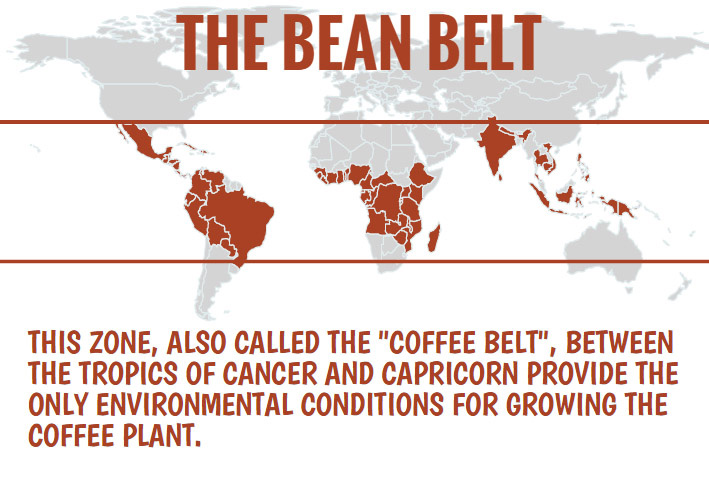HISTORY OF COFFEE
You may be surprised to find out that all of the world’s coffee is grown in the same latitude, this region is called “The Bean Belt”. Countries in this region have a hot, humid and rainy climate with rich soil, which are favorable conditions for growing coffee.
Coffee connoisseurs know that pure delicious coffee originates from a few places in this world. So why can only a few countries such as Guatemala, Costa Rica, Colombia, Brazil, Ethiopia and Vietnam can grow all kinds of good quality coffee in the world?
According to experts, although those countries are located in different regions of the world, they have one thing in common, they all are located in a row of the tropics along the equator, called “The Bean Belt”.
Most of the highest quality coffee beans are harvested in the high mountains between latitudes 25 degrees north and 30 degrees south. And of course, there is a scientific research that explains why coffee grown in this area is more better than coffee grown in other places.
Coffee expert Sam Lewontin said that coffee is “picky” and very “picky” about where it grows. The best coffee beans come from coffee plants that are grown not only in warm, humid tropical environments, but also in high terrain, ideally at 1,500 – 1,600m above sea level.
Warm days and cool nights, which are typical for tropical alpine environment, shock the natural chemicals (including organic acids, aromatic compounds and sugar) and create complex flavors for coffee beans. These flavors are then released into your coffee when you make this beverage.
A magical combination of temperature, humidity, rainfall, topography and soil quality affects coffee to a great extent. Indeed, one coffee plant can have a completely different taste compared to another coffee plant grown just a few meters away.
Central and South America, East Africa, the Pacific and India are all famous for possessing the aforementioned perfect conditions for coffee and also are the birthplace for the world’s purist premium coffee. Yet, when worldwide temperatures continue to increase, the golden lands for coffee are increasingly under threat.
One thing we are starting to witness is that the coffee belt is shifting to higher altitudes. “So lower altitudes are staying the same, and the band in which you can grow tasty coffee is sort of moving up the mountain,” said Lewontin.
Also, hotter temperatures bring on other challenges, like “roya”, or leaf rust, a devastating disease that thrives in hotter temperatures and can wipe out entire crops.
Coffee manufactures around the world are experimenting with a new coffee crop, which is capable of growth against some of the negative effects of global climate change. Lewontin hoped these efforts could be enough to save high-quality coffee in a few decades ahead.

